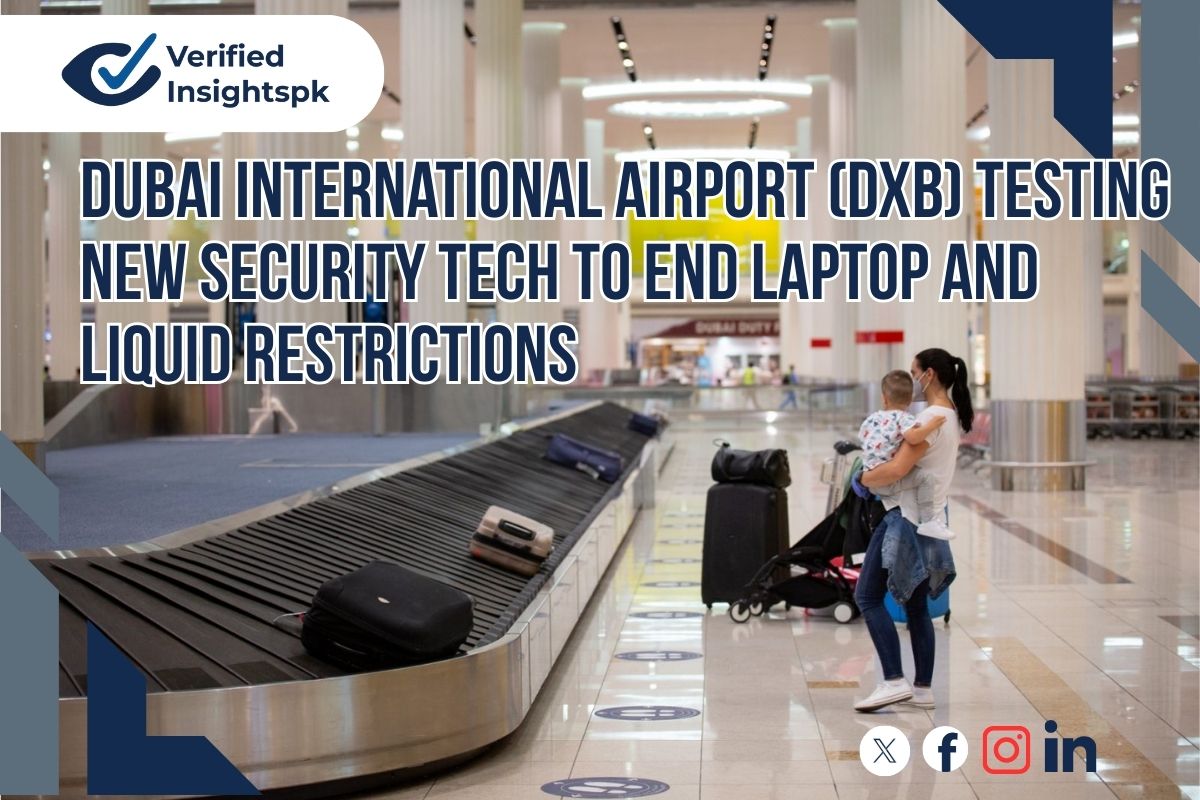
Dubai International Airport (DXB) Testing New Security Tech to End Laptop and Liquid Restrictions
Air travel is often associated with long queues, baggage checks. But the most dreaded moment is when passengers must remove laptops, tablets, and liquids from their hand luggage. But Dubai International Airport (DXB) (the world’s busiest airport) is aiming to change that experience forever. With the testing of advanced new security technology, DXB is preparing to eliminate one of the most frustrating parts of security screening: the removal of laptops and liquids over 100ml.
This groundbreaking step could not only transform the passenger journey at DXB but also set a global benchmark for the future of airport security.
A Major Step Toward Hassle-Free Travel
Dubai Airports CEO Paul Griffiths confirmed in an interview with Gulf News that next-generation security scanners, developed by UK-based company Smiths Detection, are being trialed across Terminals 1, 2, and 3.
Currently, aviation security rules worldwide require travelers to remove electronics and liquids from their bags. This process, while necessary, often leads to bottlenecks, stress, and delays at checkpoints. Griffiths believes this new technology has the power to make air travel smoother without compromising safety.
“Over the past decade, passenger numbers have grown by 20% without major additions to our facilities. Increasing efficiency in our current infrastructure is a key part of our growth strategy,” Griffiths explained.
How the New Security Technology Works
The system being tested uses advanced 3D X-ray scanning and AI-powered threat detection. Unlike traditional scanners, which only capture flat images, these devices can analyze the contents of bags in detail without requiring passengers to remove items.
Key features of the new scanners include:
- 3D imaging technology for more accurate and detailed scanning.
- Automatic threat detection using AI, reducing reliance on manual checks.
- Faster processing time for passengers and security staff.
- No need to remove laptops, tablets, or liquids, including bottles over 100ml.
In essence, the scanners combine efficiency with top-level security. They not only speed up passenger flow but also minimize human error by automating much of the detection process.
Trials Already Showing Positive Results
According to Griffiths, the early results of these trials are highly encouraging. Passengers are experiencing quicker, more convenient security checks, while staff are reporting fewer complications during screening.
“We are seeing faster and more reliable screening. Security remains our top priority, but speed and convenience for travelers are also key benefits of this new technology,” Griffiths said.
This aligns with Dubai Airports’ long-term vision: to maximize efficiency without constantly expanding infrastructure. Instead of building more checkpoints or terminals, DXB is investing in smarter systems that optimize existing facilities.
Why This Matters for Passengers
For millions of travelers passing through DXB every year, these changes could significantly improve the travel experience. No more fumbling through bags at checkpoints, removing electronics, or worrying about carrying small bottles of liquid.
Here is what it means for passengers:
- Less Stress at Security: The process becomes quicker and less disruptive.
- Time Saved: Faster lines mean more time to relax, shop, or dine inside the airport.
- Fewer Restrictions: Travelers can carry liquids beyond the 100ml rule, reducing the need for tiny travel bottles.
- Consistency Across Terminals: With scanners installed in Terminals 1, 2, and 3, all passengers can expect the same experience.
Dubai International Airport’s Growth
Dubai International Airport has long held the title of the world’s busiest airport. In the first half of 2025 alone, DXB welcomed over 46 million passengers, a 2.3% increase compared to the previous year.
This growth highlights both the challenge and importance of upgrading infrastructure. Expanding physical space is costly and disruptive, but introducing cutting-edge technologies allows airports to handle more passengers within existing facilities.
Griffiths emphasized this strategy: rather than expanding buildings, DXB focuses on boosting efficiency through innovation. This approach not only saves costs but also ensures the airport stays ahead in global aviation competitiveness.
A Global Shift in Aviation Security
The move by Dubai International Airport mirrors a global trend in aviation security. Airports in the UK, US, and parts of Europe are also beginning to roll out similar scanners. The UK, for instance, has already announced plans to phase out the 100ml liquid rule by adopting this technology across airports by 2025.
DXB’s adoption of these scanners places it at the forefront of this transformation, reinforcing its reputation as a pioneer in aviation innovation. For frequent travelers, it could soon become the standard expectation that airports worldwide will need to follow.
What This Means for the Future of Air Travel
If fully implemented, the new system at Dubai Airport could reshape how passengers view the security process. The future might bring:
- Shorter queues and smoother flow at checkpoints.
- More relaxed travel experience for passengers.
- Greater airport efficiency, allowing more passengers without major expansions.
- Higher passenger satisfaction, making Dubai not just a transit hub but a preferred travel choice.
With Dubai’s vision of becoming a global leader in aviation, this technology could be the first of many innovative steps to redefine air travel.
Final Thoughts
At VerifiedInsightsPK, we believe Dubai International Airport has once again proven why it leads the aviation world. By testing and preparing to implement new security scanners that remove laptop and liquid restrictions, DXB is setting a new benchmark for passenger convenience.
However, this initiative is more than just a technological upgrade; it is a bold commitment to efficiency, safety, and a seamless passenger experience. With millions of travelers depending on Dubai as a global hub. The successful rollout of this system could inspire airports worldwide to follow suit.
For passengers, it marks the end of one of air travel’s biggest frustrations and the beginning of smoother, stress-free journeys through the world’s busiest airport.










